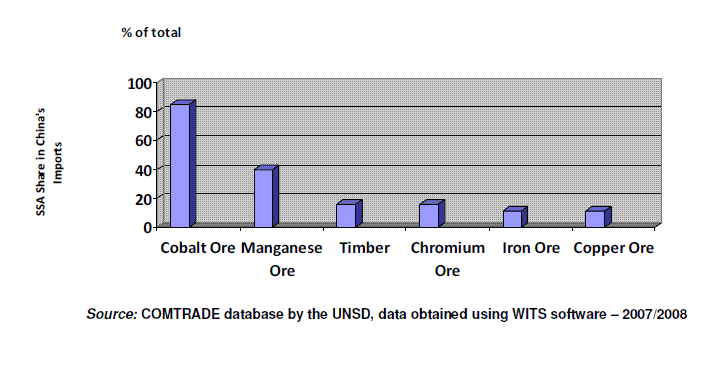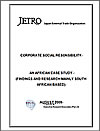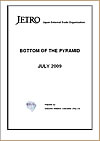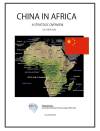China in Africa
All data are collected in the Fiscal Year of 2008-2009.
8. China's Mining Footprint in Africa
China is now the prime driver of world mineral prices and a number of Africa countrieshave become key beneficiaries of this process. The country is unable to meet its annualdemand for copper, zinc, nickel and a range of other raw materials. Consequently, Chinanow imports US$100 billion worth of base metals every year, consuming more than25percent of the world’s supplies. This includes 30 percent of global zinc output, 25percent of global lead output and 22 percent of refined copper production. Furthermore,the Chinese economy absorbs 27 percent of the globe’s iron and steel and 25 percent ofits aluminum output.
In 2003, China passed the United States to become the world’s largest copper consumerand by the following year consumed 46 percent more than the United States. In 2006,China announced plans to set up Strategic Mineral Reserve to stockpile uranium, copper,aluminum, iron ore and other minerals. The reserves are critical for providing China with abuffer to adjust to market fluctuations, manage emergencies and guarantee the security ofresource supplies.
Africa plays a critical role in the provision of key minerals for the Chinese economy. In thecase of minerals, China is almost exclusively reliant on Sub-Saharan Africa for its cobaltimports, and significantly reliant for manganese (the latter primarily from Gabon, SouthAfrica and Ghana). Sub-Saharan Africa is also an important supplier of timber (mainly fromGabon, Republic of Congo, and Cameroon) and chromium (mainly from South Africa,Madagascar, and Sudan), accounting for around one-seventh of China’s global importseach. However, with respect to China’s imports of iron ore and copper, Sub-SaharanAfrica is still a relatively small (but growing) contributor.
China has shown a growing interest in the mining belt of central southern Africa,comprising Zambia, Tanzania, and Mozambique. This area is well endowed with copper,iron, gold, manganese, and other base metals.
Sub-Saharan African share of China’s imports of selected natural resources (2001-2008)
China is now the prime driver of world mineral prices and a number of Africa countries have become key beneficiaries of this process. The country is unable to meet its annual demand for copper, zinc, nickel and a range of other raw materials. Consequently, China now imports US$100 billion worth of base metals every year, consuming more than 25percent of the world’s supplies. This includes 30 percent of global zinc output, 25 percent of global lead output and 22 percent of refined copper production. Furthermore, the Chinese economy absorbs 27 percent of the globe’s iron and steel and 25 percent of its aluminum output.
In 2003, China passed the United States to become the world’s largest copper consumer and by the following year consumed 46 percent more than the United States. In 2006, China announced plans to set up Strategic Mineral Reserve to stockpile uranium, copper, aluminum, iron ore and other minerals. The reserves are critical for providing China with a buffer to adjust to market fluctuations, manage emergencies and guarantee the security of resource supplies.
Africa plays a critical role in the provision of key minerals for the Chinese economy. In the case of minerals, China is almost exclusively reliant on Sub-Saharan Africa for its cobalt imports, and significantly reliant for manganese (the latter primarily from Gabon, South Africa and Ghana). Sub-Saharan Africa is also an important supplier of timber (mainly from Gabon, Republic of Congo, and Cameroon) and chromium (mainly from South Africa, Madagascar, and Sudan), accounting for around one-seventh of China’s global imports each. However, with respect to China’s imports of iron ore and copper, Sub-Saharan Africa is still a relatively small (but growing) contributor.
China has shown a growing interest in the mining belt of central southern Africa, comprising Zambia, Tanzania, and Mozambique. This area is well endowed with copper, iron, gold, manganese, and other base metals.
Sub-Saharan African share of China’s imports of selected natural resources (2001-2008)

Source: COMTRADE database by the UNSD, data obtained using WITS software – 2007/2008
Of these three countries, Zambia has the most advanced level of Chinese engagement. China has secured direct equity interests in copper, coal, and manganese reserves. The purchase of an 85 percent stake of Chambishi copper mine for about US$20 million in 1998 was one of China’s earliest overseas mining investments. After its reopening in 2003, the mine has seen continuous inflow of more than US$200 million of new investment, including construction of the smelter plants. The mine’s production capacity reached 150,000 tons of copper per annum in 2008. In coal, Chinese Collum Mine at the old Nkandabbwe mine in Sinazongwe district started production in 2003. In 2005, a private Chinese firm purchased a manganese mine with proven deposit of 4 million tons in Zambia's old industrial town of Kabwe. In 2006, around 27 percent of Zambia’s exports of copper were destined for China, compared to 100 percent of manganese. Politically, China’s engagement with Zambia has become a contentious issue. Opposition figure Michael Sata was active in criticizing the growing Chinese presence in the country during the 2006 election campaign, claiming that Chinese investments were exploitative” and that the Chinese should be expelled for mistreating Zambian workers. In reaction, Chinese stakeholders in Zambia tighten their relationship with the ruling party. While South Africa is a natural port of call for Chinese mining companies, competition is tough in the local mining environment while the country’s draconian black economic empowerment (BEE) criteria has made Chinese investors wary of committing large investments into the mining sector – a trend evident with mining companies from other countries, especially Canada. Therefore, compared to other countries, Chinese fixed capital investment in the mining sector has been comparatively small. However, there are recent indications that Chinese companies are looking more closely at obtaining iron ore deposits in the Northern Cape. For example, Chinese Steel giant Baosteel has obtained a share in the Australian mining company Aquila which has exploration concession areas in the Province. Other Chinese mining companies active in South Africa include: Sinosteel; East Asia Metals Investment (subsidiary of Sinosteel); Jinquan Iron & Steel (Jisco); MinMetals; Zijin Mining and PMG.
8.1. Country Case Studies

China’s intentions in Africa on the mineral extraction front, could not have been madeclearer after China announced a US$5 billion loan to the DRC for infrastructuredevelopment in September 2007, following up with the signing of another US$3,8 billion formining investments projects in January 2008. The sheer size of the loan took Westerncountries by surprise and cemented the perception that China was becoming Africa’s mostimportant development partner. Under the terms of the agreement signed by the Ministerfor Reconstruction, Pierre Lumbi,, the Export-Import Bank of China pledged the nearlyUS$9 billion loan and finance to build and upgrade the DRC’s road (4000 km) and railsystem (3200 km) for transportation routes that connect its extractive industries, and todevelop and rehabilitate the country’s strategic mining sector in return for copper andcobalt concessions. In return, China would gain rights to extract up to 10 million tons ofcopper and 420 000 tons of cobalt (proven deposits) over a 15 year period, with operationsexpected to begin in 2013.
The agreement stipulated that only one in five workers can be Chinese. In each of theprojects half of one percent of the investment must be spent on transfer of technology andon training Congolese staff. One percent has to be spent on social activities in the region,and three percent to cover environmental costs. Ten to 12 percent of the work has to besubcontracted to Congolese companies.
The DRC National Assembly approved the agreement in May 2008, involving Groupementd’Entreprises Chinoises – a Chinese conglomeration involving China Railway EngineeringCorporation (CREC), Sinohydro Corporation and Metallurgical Group Corporation, whichwill control a total of 68 percent of the new Joint Venture Sicomines, with the rest of theshares held by Gécamines and the DRC government.
Other than long distance road and rail construction, the package also includes two hydroelectricdams and the rehabilitation of two airports. If fully disbursed, this will be the singlelargest Chinese investment in Africa. No other country or international financial institutionhas come close to initiating such a massive project in such a short period of time. SomeWestern diplomats privately expressed the view that if implemented properly, the dealcould be good for the DRC.
Yet almost immediately the size of the loan elicited public criticism from the InternationalMonetary Fund (IMF) that the DRC was taking on too much debt. In reaction, recentreports suggest that the loan may be paired back to US$6 billion. Additionally, thedownturn in the commodity cycle has also seen many Chinese mining firms shut downtheir cobalt operations in the DRC. However, it has been the ongoing fighting in theeastern Congo which has seen China put all development linked to the loan on hold untilsuch time as the security situation improves - this after several of its expatriate workershave become victims of armed robberies, heists and hijackings in eastern DRC, includingreports that one Chinese worker had his head cut off and left impaled on a stake. MostChinese expatriate mining compounds in eastern DRC have been closed down andpersonnel moved to safer areas and in some instances relocated out of the country toplaces like Angola.

China’s determination to access critically needed raw materials has been no more betterillustrated in the chaotically unstable but mineral rich country – Guinea Conakry. Theshock letter written by Conte’s former Secretary General, Sam Mamady Soumah in earlyJuly 2008 to Rio Tinto rescinding its potentially massive iron ore reserves in the Simandouconcession sent shock waves through the mining fraternity.
Rio Tinto’s top management had been aware of “rumours” about “under the tablenegotiations” for the Simandou concession taking place between the government andfirms such as BHP-Biliton, Benny Steinmetz’s BGP and certain Chinese ventures.
Indications are that the late president Conté wanted the Rio Tinto/Simfer combine tospeed-up investment in the local transformation of the ore deposits, after receiving aChinese proposal to build the rail links for Dabola and Tougué. This was strengthenedround about the same time that Rio Tinto received the expulsion order from the Simandouconcession, with Guinea and China discussing a deal, which could see billions of dollars ofChinese investment flowing into country in exchange for mining rights. Facing financialpressures, Rio Tinto made it clear that it was not willing to commit to any new expansionplans in Guinea Conakry until global economic condition improved. The company felt thatthe agreement it had with the government allowed for this delay. The governmentdisagreed, however.
The Chinese Offer
During July 2008, a delegation, including officials from the Chinese Development Bank(CDB) spent a week in Guinea to discuss a range of investment projects with state andprivate sector investors, while the President of the National Parliament, El Hadj AboubacarSomparé visited China from 13-20 July 2008. According to Ousmane Dore, GuineanEconomy and Finance Minister, further missions were expected to go to Beijing over thecoming months to meet with the Chinese companies about the operational details of thisagreement. A “strategic committee” has been formed to oversee and implement plannedprojects in the country. By making bauxite and iron ore available to the Chinese, Guineacould unlock an overall sum of investment that could support these projects.
Importantly, according to reliable sources, these meetings resulted in promises of massivefinancial aid to Conakry which were the prime reason behind the cancellation of Rio Tinto’sSimandou concession.
Guinea’s parliamentary speaker was invited by his Chinese counterpart, Wang Jiarui, andattended several briefings (at the China Development Bank and at Henan InternationalMining Corp’s HQ in Henan), where, according to one reliable source Jiarui formulated theidea that Beijing could offer Conakry a mineral investment solution free of the IMF andWorld Bank’s fine print on strict conditions and draconian monitoring requirements. Anenthusiastic Somparé arrived back in Conakry, holding a meeting with Conté, explainedthat the Chinese, desperately lacking aluminium, would give “everything” for Guinea’sconcessions: roads, hospitals, dams, food, machinery, schools, even entire cities.
The Chinese were again contacted, this time by Prime Minister Souaré, who met PresidentHu Jintao in Beijing, during the Olympic Games in September, as well as the heads ofChina-Eximbank, the CDB, and a consortium of metal and non metal mineral companies,including powerful Chinalco – once already involved in an ambitious plan to developGuinean Bauxites but canceling it due to Conakry’s demand of the involvement of severalmiddlemen” networks).
He also traveled to Zengzhou, in the Henan province, where he met the heads of therecently formed Henan International Mining Corp. Ltd, the consortium that in principlewould explore the Simandou concession, and other bauxite treasures in Guinea. Thisconsortium includes at least 8 to 12 companies: Yongcheng Coal, Henan YongshangMetals and Minerals, Xuchang Minerals and Industry, Henan Hongxing Mining Machinery,Henan Ruishi Special Refractary Co., CAEC, etc. The Chinese were reportedly offered ashare of 41 to 50 percent on the whole Simandou iron ore area, if, in return, they wouldoffer a “sustainable all round development plan” for the country.
In the end part of the Simandou concession went to Israeli entrepreneur Benny Steinmetz.His ability to develop the deposits are highly questionable. China’s appetite to Conakryhas dipped somewhat given the political confusion in the country – even considered toorisky for Chinese companies, while world economic conditions remain poor.
Towards the end of 2008, another Chinese joint venture, Henan International Mining Co,started negotiating the granting of several bauxite permits in the west of the country. Thelicenses cover 558 km2 and hold and estimated 10 billion tonnes of ore. The joint venture,created on 26 September 2007, includes China Henan International Cooperation GroupCo Ltd (Chico, 41 percent), Yongcheng Coal & Electricity Group Co Ltd (51 percent),Henan State-owned Assets Operations Co (4 percent) and Henan Zhonglian Mines Co Ltd(4 percent) and has capital of US$ 26,5 million.
8.2. Recent Mining Developments
- In January 2009, Liberia has signed a US$2,6 billion agreement with China Union todevelop its main ore mine. China Union has promised to build a one-million-tonne-ayearrefining facility at the Bong iron mines, which are situated approximately 150kmfrom Monrovia.
- On 24 April 2009, China granted Niger a US$95 million preferential loan to expanduranium production. China’s National Uranium Corporation (SINO-U) is expected toproduce 700 tons annually when production reaches capacity next year.
- The China Non-Ferrous Metals and Construction (CNMC) and Yunnan CopperIndustry is set to commission a US$300 million copper smelter in Zambia’s Chambishitown. The town is now a tax-free economic zone, intended to attract Chinese investors.
目次
- 1. Introduction
- 2. Africa in the Context of China's Resource Acquisition Requrements
- 3. The Origins of China's New Africa Policy
- 4. The Role of FOCAC
- 5. China's New Resource Acquistion Business Model
- 6. The Role of Chinese Institutions in the Acquisition of Business Intelligence
- 7. China's Energy Footprint in Africa
- 8. China's Mining Footprint in Africa
- 9. China's Telecommunications Footprint in Africa
- 10. China's Infrastructure Footprint in Africa
- 11. The Role of China's Financial Institutions
- 12. Implications for Japanese Investors
- Annexure I: The Focac Fuc Structure
- Appendix II: The Forum on China-Africa Cooperation
- Annexure III: Ministry of Commerce
- Annexure IV:Profile Chen Yuan and Chi Janxin




